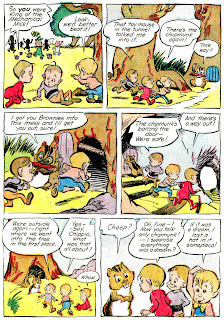Harvey Kurtzman, one of my favorite comic book creators of all time, started his comic book career working for the Louis Ferstadt comics shop. Kurtzman earned his genius status over many years of toiling in the comic book factories, like drawing one-page gag strips for Stan Lee until landing his gig with EC Comics. When Kurtzman created, edited and wrote Mad it basically sealed him in comic book immortality.
But these early strips, “Flatfoot Burns,” six-page fillers which appeared in Police Comics, are the work of a 19-year-old artist looking to make a living in comics. Kurtzman was dismissive of this early work. As written in Kurtzman’s bio, Art of Harvey Kurtzman, Mad Genius of Comics, by Denis Kitchen and Paul Buhle, Kurtzman is quoted as saying: “‘I never had a style so I had nothing to sell.’ In another interview Kurtzman referred to his pre-war output as ‘very crude, very ugly stuff.’ Nonetheless these give subtle hints of what is to come.”
When you look at these strips you will see panels here and there that are foreshadowing the future and his work on Mad and beyond. Mostly you are seeing a young cartoonist learning his way. These three stories are from Police Comics #24-26 inclusive (1943. When reference is made to “pre-war” in the biography I assume it means that period before Kurtzman entered the service.
More about →
But these early strips, “Flatfoot Burns,” six-page fillers which appeared in Police Comics, are the work of a 19-year-old artist looking to make a living in comics. Kurtzman was dismissive of this early work. As written in Kurtzman’s bio, Art of Harvey Kurtzman, Mad Genius of Comics, by Denis Kitchen and Paul Buhle, Kurtzman is quoted as saying: “‘I never had a style so I had nothing to sell.’ In another interview Kurtzman referred to his pre-war output as ‘very crude, very ugly stuff.’ Nonetheless these give subtle hints of what is to come.”
When you look at these strips you will see panels here and there that are foreshadowing the future and his work on Mad and beyond. Mostly you are seeing a young cartoonist learning his way. These three stories are from Police Comics #24-26 inclusive (1943. When reference is made to “pre-war” in the biography I assume it means that period before Kurtzman entered the service.




















-GONE-FISH.jpg)
















































